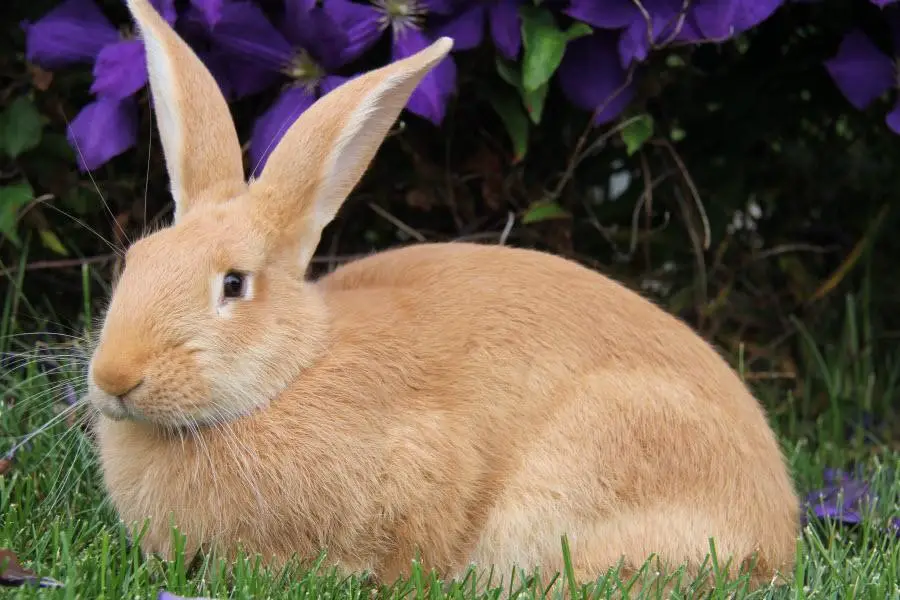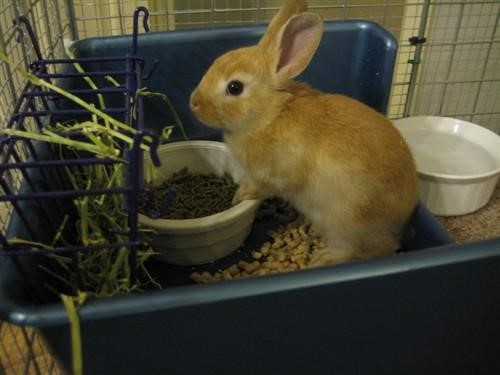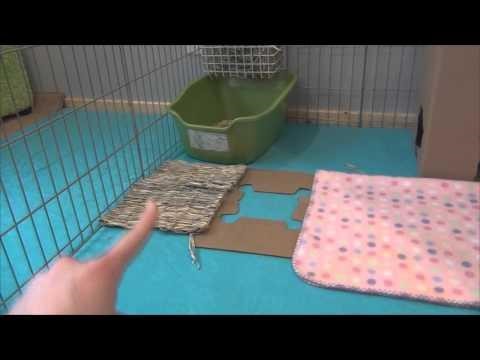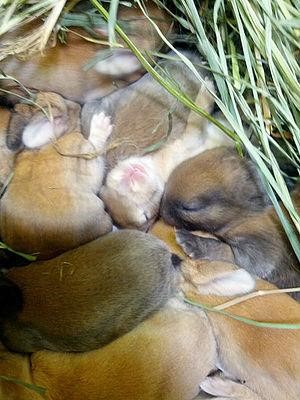Scientific Facts
| Common Name: | Palomino Rabbit |
| Scientific Name: | Oryctolagus cuniculus |
| Life Span: | 8to 10 years |
| Size: | 8-10 pounds |
| Habitat: | Grasslands, forests, woods, meadows, wetlands, and deserts |
| Country of Origin: | United States of America |

Physical Description
The Palomino rabbit is a large and meaty type. Commercially, its value as meat is high, but bone structures are smaller. They need some time to be mature. A palomino in its pre-junior stage does not exceed 5 pounds, and the juniors weigh not exceeding 8.5 pounds but 4 pounds as its minimum weight. The junior bucks weigh from 4 to 8 pounds, while the intermediate does not go over 9.5 pounds; their intermediate bucks are at 9 pounds.
The adult female weighs between 9 to 11, but the ideal is 10. Senior bucks are lighter from 8 to 10 pounds, but ideally, it is 9 pounds. Their body type is of medium length having well-rounded hindquarters, while the shoulders are well-developed and broad. The eyes are brown, and the ears are uptight and large. Their top line goes upward starting from the neck, goes up the loin hip and goes down to the tail. The coat is full and coarse, while the fur is flying back. It is advised to do weekly brushing. In spring, increase the brushing during the molting period.
They are golden colored, having the varieties of lynx and golden. Genetically, their golden color is a shade of bright gold having cream to an under color of white. The lynx is a diluted version of gold and is called cream by most breeders. It is then an outer color of medium pearl grey having complements of orange beige and cream plus a white under color.
Lifespan
Averagely, Palomino rabbits live for 5 to 8 years, but they can live for 10 years in captivity.
Other Information
They are good pets for families, the elderly, singles, and novices. The children should be guided by adults regarding how to raise and handle rabbits for rabbits can scratch and bite.
Rabbits should not be left outdoors with no shelter and housing that would protect them from predators. Their conservation status is not listed by the American Livestock Conservancy. They are recognized by the ALC. They are accepted in Lynx or Golden.
Behavior
Palominos love being out of their cage. They do well with the children, given that they are carefully handled. For them staying inside their enclosure for a long time is depressing and boring, especially if they are alone. In terms of maintenance, their need is relatively low so long as you make them happy, healthy, happy and safe. Seniors and couples may find this pet good for these rabbits are sociable.
Compared to other animals, training them is harder, but it is still possible with the owner’s perseverance, time, treats, and patience. Make sure there are bunny toys for them. Some of them tend to be picky of their toys while others are just contented with pieces of wood or cardboard. You should figure out what type of toys your bunny wants.
Palominos are sweet, gentle, cute, calm, and friendly. They are smart potty users when trained well. In addition, they raise their offspring and have good health. When talking, they do grooming themselves and other bunnies. They are active in the evening and in the morning and do their feeding in the evening mostly. They sleep averagely for 8 hours.
These rabbits have excellent hearing, smell, and vision. Having big eyes on their head’s side gives them a vision of almost 360 degrees, making them see predators or threats from any directions. They are able to see everything either in front or behind them. In front of their nose is a little blind-spot.
They are tough, have excellent production traits, and grow fast. They are ideal for meat production. They are also used for a rabbit show. They are mostly known for their big shoulders and big ears. It is best not to hold them for a long time. Keeping them stay or play on the ground is much better. This breed is not a pure one; instead, they are combinations of several breeds intended for petting and commercial purposes.
Diet and Feeding

These Palomino rabbits are herbivorous. Their diet is 70% hay, but they also eat fruits, pellets, leafy greens, and vegetables. The hay would be Timothy grass hay. It is rich in fiber known for preventing obesity, hairballs, and diarrhea. Although leafy vegetables are good, they should not be given often for digestive problems to be avoided.
Treats should not contain much starch or sugar, but you can give carrots, papaya, apples, strawberries, and others. To supplement their diet, high-fiber pellets should be offered. Be sure to always put clean and freshwater either on a water bowl or a sipper bottle.
Care Requirements

Palomino rabbits don’t want to be in their enclosure for a long time. They want more time outside to interact and explore. They do well in outdoor or even indoor enclosure for their coats are coarse and dense, enabling them to deal with cold temperatures, even snow.
However, outdoor enclosures should still be covered on the 3 sides to protect them, while indoor enclosures can be made for wires for a solid bottom for safe beddings. The bedding should be cleaned every day and changed every week.
Breeding

Medium to large-sized rabbits are mature sexually at their 4 to 4.5 months; the bigger once are from 6 to 9 months. eggs are released after sexual intercourse. They are receptive to breeding in about 14 in every 16 days. The females are receptive when their vaginas are moist and red. In other words, they are not receptive when there is a whitish and pink color in the vagina and a little or almost zero moisture. To detect pregnancy, feel the female’s embryo. Do this 12 days after mating. Take note there are false pregnancies. This is common among rabbits.
If your pet is pregnant, it will be about more than a month. Mother bunnies who have a small litter do have longer pregnancies. If a mother bunny fails to give birth after 32 days, the vet must induce labor, or else dead litters can happen. Pregnant bunnies resorb or abort their fetuses occasionally as caused by diseases or nutritional deficiencies.
After almost a month after they bred, put a nest box. Don’t put it too soon as the bunnies will just defecate on it. Before the female gives birth, she pulls her fur and makes a nest in the nest box.
Then, baby bunnies are born deaf, blind, and naked. After a month, their hair shows and ears and eyes will be opened on day 10. They are not able to regulate their body temperature. After giving birth, the mother bunny can do breeding again.
A medium to large female rabbit has 8-10 nipples and gives birth to 12 or more. If a mother bunny cannot nurse all the babies, the babies can be fostered. Take them from their nest box for the first 3 days and let the other do with smaller litter do the fostering. This increases the chance of survival.
Mother bunnies nurse once or twice every day for 3 minutes. The kits are weaned at 4 to 5 weeks. They can be hand-reared; however, they could die. They must then be dry, quiet, and warm. For their formula, mix a half cup of evaporated milk, half cup of water, egg yolk and a tablespoon of corn syrup. You can give it half a teaspoon- 2 tablespoons. That would depend on their age. They can start eating green on days 15-18.
Owners should keep an eye on the do because they tend to eat their young due to nervousness, extreme coldness, and neglect to nurse. Dogs or other predators make the doe nervous leading to killing or eating of the young. If this action happens repeatedly, this doe must not be used to breed.
Breeding Characteristics
Palomino does are very good mothers having a decent litter size. They possess good maternal instincts, but some can be moody during the breeding. Kits can start eating alfa pellets and drink water after their eyes are opened at 7 to 14 days after they are born.
Even when they start eating, they cannot be weaned yet. It will be up to the doe. Kits should not be taken from their mothers for 2 months. This is important for their growth, health, and development. Mom’s milk is needed by the kits.
Why You Should Breed Rabbits
- Rabbits are great pets. They are cute and adorable that children would love to raise them as pets. Thus, breeding rabbits would be so nice for the pet market.
- Rabbits are quiet. They don’t make a lot of noise, unlike other pets. They don’t cause any disturbance to anyone in the house or in the neighborhood.
- Rabbits need low maintenance. They don’t need much care and attention, unlike other livestock out there.
- Rabbit meat is healthy. Their meat is considered healthier than other meats having high protein and low cholesterol and fats.
- Rabbits shows are popular. Thousands of shows using rabbits are shown and judged by ARBA. Showing is a great and enjoyable hobby.
- Breeding is economical. You can save money so long as you know how to raise and sell your pet.
- Rabbits are fun and awesome to raise. They are diverse and amazing species to raise.
Life Stages of a Rabbit
Juvenile 1-12 Months
1st month
- The baby rabbits are kits.
- They are born scantily furred while the eyes are closed. They are fully dependent on their mother for the first 3 weeks.
- On day 7, their furs start to grow while eyes start to open at day 10 and ears open too on day 12.
- The mother nurses them 1 or 2 times a day for 5 minutes.
- In the 3rd week, they produce and eat caecotrophs.
- From 3 to 5 weeks, they start to eat solid foods.
2nd Month
- At 6 to 8 weeks, kits are 100% independent.
- They can start a bond with their owners
3rd Month
- They should take their vaccination against Calicivirus to avoid viral diseases.
- In the 12th week, males and females can be separated. This is the puberty stage.
4-6 Months Old
- It is due to Calicivirus.
- There will be changes in their behavior as the young become sexually mature. It is recommended to do neutering.
- The males can take their castration at 4 months, and the females can have a spay procedure at 6 months.
- Microchipping would make a permanent identification of your bunny. This is helpful if they escape or dig.
6-12 Months Old
- At 10 months old, the small ones reach their maturity weight while the big ones are at 12 to 14 months.
Diet for Juveniles
They are herbivores having 80% hay and 20% of the fresh and green veggies. They can eat alfalfa or Lucerne. These have high protein and calcium levels. Growth pellets can be given too.
Young Adult 1-2 Years’ Old
Their diet would be grass or oaten hay, adult pellets, and green veggies. Pellets would be one-fourth cup or less for 2 kilograms of their body weight a day. Don’t overfeed them with oats, as it can cause obesity and diarrhea. Pellets make them grind teeth vertically instead of lateral motion. A good diet having fresh veggies and hay is mostly recommended.
Environmental Enrichment
Spend more time playing and giving them lots of toys. Toys will amuse them. They can be taught to do tricks. A training session should be short. Positive reinforcement and repetition should be used. 4 hours of exercise should be given for physical and mental health.
- Have a Calicivirus booster yearly.
- Do check-ups regularly for disease prevention.
Middle-Aged
- Continue the Calicivirus booster.
- As they get old, don’t overfeed them. Give them treats as an exchange for forage. Foraging is a way to exercise.
- Visit the vet for regular check-ups.
Geriatric 6 Years Old And Above
- If well maintained, they can live for 12 years. This age is susceptible to diseases like cancer, arthritis, and more.
- Make some adjustments for greater comfort. Give a warmer house, and padded surfaces easily accessed ramps. Maintain their weight and do the necessary treatments.
- Go on with a Calicivirus booster and see the vet.
Common Rabbit Diseases
Rabbits are prone to some diseases. It can be prevented if owners understand and know how to manage his pet. Owners should be observant in terms of their pet’s health.
The more common ones are snuffles, uterine tumors, overgrown teeth, Haemorrhagic Disease Virus, and myxomatosis.
Overgrown Teeth
Rabbit’s teeth grow continually all through their life. if they fail to grind teeth constantly by not eating fiber, then molar teeth come out with spike damaging their tongues and cheeks. This would stop them from eating. With that, they can die. To prevent this, give a diet high in fiber like grass hay or oaten. Then, offer leafy greens and pellets. To treat, burring the teeth, making it flat would fix the overgrown teeth.
Snuffles (Pasteurellosis)
This is transmitted through close contact with a rabbit that is infected. Pasteurella multocida, a bacterium, is the main cause. It affects the nose and eyes. The eyes release discharge, making it red and squinting. The nose gives off discharge, too, making your bunny sneeze. Ears, abscesses and uterine are also affected. To prevent, don’t let your bunny suffer stress. New rabbits must be quarantined first before introducing them to other bunnies. Treatment requires antibiotics or surgery.
Hairballs (Trichobezoars)
For self-grooming, rabbit’s hair is found in the stomach, but if rabbits cannot vomit, the hair must go and pass through their gut. If this fails to happen, there will be obstruction and complications. With this, your bunny would not eat and be lethargic. To prevent, high-fibered food should be fed to them. To remove the blockage, surgery is done, or sometimes medication is given instead of surgery.
Uterine Tumours
The females often experience this. The symptoms are lethargy, cysts in the mammary gland, vaginal discharge having blood, and being aggressive. Desex at 4 to 6 months age is a way to prevent and treat.
Myxomatosis
This is a virus transferred by fleas or mosquitoes. There will be discharge and swelling in the eyes. There is no vaccine to this, but you can prevent by putting mosquito-proof hutch or take your rabbit inside when the mosquito comes out.
Rabbit Haemorrhagic Disease Virus
It is transmitted by mosquitoes and flies. There are vaccines given. Symptoms are fever, lethargy, poor appetite, and restlessness. The liver is damaged, leading to blood clots. Don’t let your bunny have direct contact with infected ones or even those wild and domesticate ones. Wash your hands before you handle them. Have an insect control.
How to Care
- Get a cage. The cage should be sturdy and spacious, letting your bunny roam on it. The minimum size is 12 square ft. It should be wide enough for your bunny to stretch out. It should be high enough that its head doesn’t touch the ceiling whenever it stands. Your bunny should be able to hop in it 3 to 4 times.
- Buy supplies for the cage. The room should accommodate water and food dishes, a cat litter box, and another box for resting. They should fit the cage easily. Water can be in a ceramic water dish or a sipper bottle. Rabbits seem to like the ceramic dish, though. Litters must be from the pelleted paper. This is eaten sometimes and passes through their bodies without causing any harm.
- Get a pen. This is to let your bunny hop and get exercise. Be sure your bunny gets easy access to the cage. Put one or two litter boxes. When you take your bunny for the first time, confine it to the cage until it uses the litter box. After then, you can let it out and do some exercise.
- Choose rooms where your bunny can roam around. Pick one or two may be the living room or other areas where your family stays.
- Secure your electrical cords. Proof your house from bunny’s chewing. Covers the cords to keep them out of the bunny’s sight so they will not be chewed or cause electrocution to the rabbit.
- Protect wooden surfaces. Again, rabbits tend to chew furniture legs, door edges, and more even wallpapers, carpet, and sheetrock.
- Prepare items to be chewed like fresh branches, paper towels, and more.
- Give water to them at all times. Freshwater should be served daily. Clean the bowls and dishes every day by washing them in dish soap and warm water.
- Provide grass hay always. Hays contain fiber necessary for their diet.
- Don’t forget to offer pellets too. Remove the uneaten or spoiled ones. Young ones can have pellets all day as they grow.
- Feed them green veggies like lettuce, bokchoy, carrot tops, and more. 2 to 3 cups a day for an adult. Introduce green veggies slowly so as not to cause diarrhea.
- Don’t give human foods except for green veggies, corn, grains, and seeds.
- Desex, your rabbit. If you don’t want to go breeding, have it neutered or spayed. These prevent unwanted pregnancy, reduce negative behavior, and lower illnesses.
- Go for an annual check-up. Bring your pet to the vet once a year. The teeth must be checked. Assess your pet’s health every day. Examine the eyes or nose, see for drooling, not drinking or eating, swelling or redness, fur loss, diarrhea, dark urine, and fever.
- Know your pet’s temperament. They love hanging out with humans. Some may not want to be picked up. Don’t touch them unless you have to.
- Provide toys and other amusements. A cardboard tube is enough by making some holes. These are cheap and can be replaced easily.
- Allot time every day. Sit with it as it eats and plays. Brush it to remove some loose fur, toss some toys, or stroke them for them to feel they are loved and valued.
Fun Facts
- Bunnies and rabbits mean the same. There is no difference at all. It is just what word we choose to use.
- Hares and rabbits are lagomorphs.
- Lagomorphs were classified first as rodents.
- Hares are born having their eyes open, and hair covers their bodies. They can even run just after a few minutes of being born, while rabbits are born naked and blind.
- Jackrabbits have a speed of 45 miles per hour.
- Rabbits are associated and used as a symbol for Easter.
- The rabbits are so clean. They are easy to train and so some tricks.
- When rabbits are happy, they do binky. This is by jumping in the air, twists, and spins around.
- The term kit is for a baby bunny. Doe for a female. Buck for a male and herd for a group of a rabbit.
- Rabbits are fed on plants and grasses.
- Their average family size is from 4 to 12 babies. Females can reproduce at 4 months. in a year, a doe can have 800 children, great-grandchildren, and grandchildren.
- Rabbit’s teeth do not stop growing. They need to chew all the time to keep the teeth short.
- Rabbits and horses are similar. They are both similar in terms of their eyes, ears, and teeth, even their behavior and diet.
- A symbol of a rabbit is used in some products to show that the product is tested on rabbits for safety testing.
- Rabbits cannot vomit, thus give only fresh, appropriate, and healthy food.
Myths About Rabbits
There is a lot of misleading information about rabbits, such as their diet, interaction, and living space. Again, rabbits are full of cuteness and charm. They are fun to play and watch in their adorable size. They are not noisy, like other pets. Here are some myths about them.
- They are low maintenance pets. Some think that raising a pet is cheaper than a dog or a cat. Rabbits need more delicate care from their living space to diet. Their enclosure must be cleaned daily. Freshwater and food must be given too. Withered veggies are not for them. Only fresh foods suit their sensitive digestive system.
- They don’t require veterinary care. They need vaccination as protection from diseases, for they are prone to illnesses. Rabbits disguise their disease. They should be taken to the vet for check-ups.
- They love to be cuddled. The chubby ones especially cannot resist hugging, but they should be carefully and properly handled. They don’t like being carried and picked. Once threatened, they bite or scratch. If mishandled, they become aggressive. With kids around, owners should pay attention to handling them.
- They are happy to stay outdoor. We love seeing them happy, but at times some owners neglect and forget them outside, and let them stay outside would expose them to severe weather, parasites, fleas, or predators.
- They don’t need much attention. They are not independent pets. Giving them food and water is not enough. Much care, time, and attention are needed.
- They are smelly and dirty. If owners don’t clean their cage, this can happen. An owner must then observe husbandry to keep the pet healthy, happy, and live longer.
- They love carrots. Only Bugs bunny love carrots. Actually, rabbits eat grass hay and veggies although it can eat carrots.
Pros and Cons of Raising a Rabbit
- Rabbits are easy to live with. They are friendly, especially if they are accustomed early. They behave and enjoy people’s company. They are faithful companions, in fact. They are good with kids who spend lots of time at home with them. They can also adopt for outdoor and indoor. Owners must understand that sometimes they want to spend time alone or interact with humans.
- Rabbits have many breeds and personalities. Rabbits come in various styles and breeds. Each breed has its own traits and personalities. Before raising a pet, check the characteristics first to see what suits you the most.
- Rabbits are obedient and clean. They can be trained and take orders. Although the tricks they know are just simple, they can still be fun. If owners fail to clean their cages, rabbits get stressed and negatively affected.
- Rabbits are disordered and destructive. It means they love chewing laces, plastic, electric cables, and more. This is due to their non-stop growing teeth. They need something to chew. They also scatter food in the house. Therefore, the owner must be considerate of this pet’s aspect.
- Rabbits need space, money, and work. Again, they tend to be messy. Thus, cleaning up is needed. They also need hay as fodder. Space should be large enough for their comfort. Lastly, you have to give them the right food and bedding. Include the vaccinations too.
- Rabbits are not friends with either cat or dog. They are natural prey to these animals. That is why making them leave together would be a problem.
Availability: Where to Get One?
Palomino rabbits can be purchased online from breeders selling online. They are also available at pet stores near you or go to adoption organizations.
Signs of a Healthy Rabbit
Below are the signs of a healthy rabbit.
- Alert Expression. Rabbits show a keen interest in their surroundings. They should show enthusiasm in seeing you. lethargy and dullness is an indication of a problem. Rabbits could hide their injuries or illness not to look weak in front of their predators. For owners, they should be keen on observing their pets.
- Clean and dry nose. They should have dry nostrils. Sneezing and nasal discharge could be symptoms of Pasteurella.
- Bright eyes. Their eyes should be free from discharge. Watery eyes indicate snuffles or allergy.
- Clean ears. These are iconic for rabbits. Clean ears are important for their health. Take note of crusty, scabby areas inside their ears. These could be signs of ear canker. It should be free from dirt, wax, mites, and debris. Their body temperature is controlled in the blood vessels. It will be your way to detect a fever or change in the bunnies’ temperature. Keep your pet in a cool area and avoid overheating. A tilt in the head could be a problem inside the ear.
- Correct Teeth. They grow continually their whole life. They are prone to dental problems. Misalignment of their teeth could be a problem. Too much drooling is a sign of dental issues.
- Healthy Fur. Rabbits undergo seasonal molting. Take note of dull coats, bare spots, hair loss, and too much itching as they are indications of illness and parasites.
- Fabulous Feet. Monitor the toenails daily. Trim them regularly. Watch out for crusty, weepy, and sore spots in the feet. Abnormal gait during a walk is a sign of limping.
- Good appetite. A healthy rabbit has a good appetite. When it shows disinterest in eating or drinking, do a further investigation.
- Healthy Weight. Your bunny should not be overweight and neither too thin too.
- Normal Droppings. Feces should be uniform in size, round, and has hay mostly. Check for abnormal signs.
FAQs
How big do Palomino rabbits get?
Palominos are large rabbits weighing 4 to 4.5 kilograms or about 9 to 10 pounds.
How long do Palomino rabbits live?
Averagely, they live for 8 years, but others could live for 10 years.
Is a rabbit a good pet?
Yes, it is. Rabbit is a wonderful pet indoor or outdoor. It is cute and adorable. Before raising a rabbit, be sure it suits your lifestyle, and you can provide its needs.
What are some facts about bunnies?
Doe is used to calling a female bunny while the buck is for the male. The young rabbits are kits. Their ears could be as long as 10 centimeters.
Do pet rabbits smell bad?
Actually, they are very clean, having odorless furs. They can smell bad if their cage is not cleaned.
Why do bunnies die?
Bunnies die for some reason. Dying from a disease is seen as the number one reason for their death.
How long can a rabbit be left alone?
They are not really independent animals. Leaving for two days would be enough.
Rabbits are not particularly independent, so they can’t be left on their own for more than two days.
What is special about a rabbit?
They are special for their cuteness and charm.
Do rabbits remember their owners?
With frequent bonding with their owners, rabbits can establish a strong bond with them and know their owners too. They recognize their owner through their voice and sight.
Are rabbits dirty?
No, they aren’t. They even do grooming themselves. Some enjoy baths, in fact.
Why do rabbits die when they get wet?
Wet fur for a long time without being dry can lead to hypothermia. Take note that drying the hair with a dryer can burn bunnies’ skin.
What foods are toxic to bunnies?
Don’t give these foods to your bunnies; walnuts, cereal, avocado, yogurt drops, silverbeet, bread, crackers, pasta, hamster food, and more.
Do rabbits cry?
Yes, they do but not as how humans cry. They need to be in severe pain or sad state. They have tear ducts that could make them cry, scream, or whimper.
Why do rabbits scream when they die?
This is called the death scream. They do this when they know their time of death is coming.
Are rabbits dangerous?
No, they are not. They are friendly, sweet, and gentle. They are, in fact, great companions to anyone.
Do rabbits have a personality?
Yes, they do. They are affectionate, sociable, and intelligent though at times they can be vengeful, bratty, and willful.
Do Rabbits love you?
Certainly. They are very loving and sociable, especially to their owners. Allotting time with them is needed.
Do rabbits apologize by touching heads?
Yes, they do. They crouch and tuck their heads to apologize.
Do rabbits fart?
Yes, they do. The gas is from the cecum goes to the colon and out of the anus.
Can rabbits sleep in bed with you?
Sure, but your room should be bunny proofed. Make sure you train them to use a litter box. Kits should not sleep in your bed.
Do Rabbits know their names?
Yes, they do. They understand their names and some simple and short words.
Do rabbits have memories?
Yes, they do. They have good emotional memories.
Do rabbits get jealous?
Apart from getting jealous, they feel love, fear, grief, anger, and more.
Who eats a rabbit?
In the wild, they are eaten by cats like cougar, leopard, and bobcat, including coyotes and dingoes and even birds.
Do rabbits scream when they die?
Yes, they do. They scream if they feel they are dying or scared. Others scream more.
What smell do rabbits hate?
They dislike garlic and egg smell. To protect your garden from them, have a mixture of egg, garlic, milk, dishwashing soap, and tabasco sauce.
Do rabbits bring bad luck?
This is a superstition related to carrying a rabbit’s foot.
Is it harmful to keep a bunny in a cage?
Keeping them in a cage is not bad, but to keep them all day in the cage would make them lonely and bored.
Can a rabbit die from a bath?
It can be traumatic for them. They can tolerate being submerged in water, and the shock could kill them.
Do rabbits feel pain?
Yes, they do. They can feel pain like humans.
Why is my bunny’s eye-watering?
It is an indication of illness near the lining of a tear duct.
Do Rabbits eat their own poop?
Yes, they do. They eat their own poop and have it digest for the second time. there are 2 kinds of poops the round and black one and the soft ones known as cecotropes.
What do bunnies do for fun?
For fun, they play with their toys like wood, straw, and others.
Why is my rabbit hiding?
They hide when they are threatened by predators or feeling stressed, afraid, and unwell.
Where do Rabbits usually live?
Rabbits live in grasslands, forests, woods, meadows, wetlands, and deserts.

